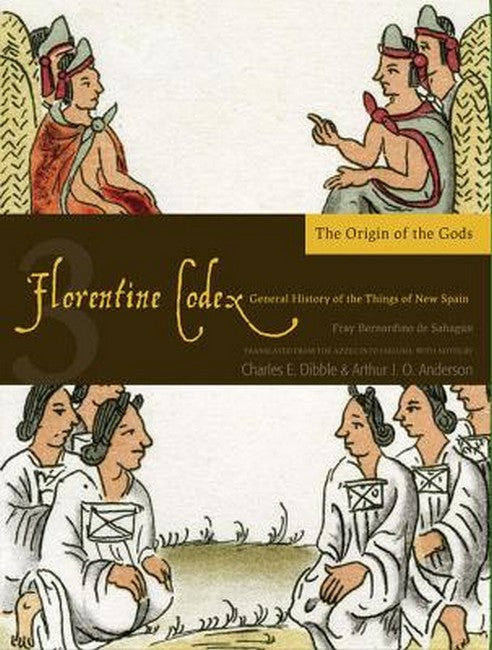Arthur J. O. Anderson (1907-1996) was an anthropologist specializing in Aztec culture and language. He received his MA from Claremont College and his PhD in anthropology from the University of Southern California. He was a curator of history and director of publications at the Museum of New Mexico in Santa Fe and taught at a number of institutions, including San Diego State University, from which he retired. Charles E. Dibble (1909-2002) was an anthropologist, linguist, and scholar specializing in Mesoamerican cultures. He received his master's and doctorate degrees from the Universidad Nacional Autonomo de Mexico and taught at the University of Utah from 1939-1978, where he became a Distinguished Professor of Anthropology. For their work on the Florentine Codex, both Dibble and Anderson received the Mexican Order of the Aztec Eagle, the highest honor of the Mexican government; from the King of Spain the received the Order of Isabella the Catholic (Orden de Isabel la Catolica) and the title of Commander (Comendador).
Request Academic Copy
Please copy the ISBN for submitting review copy form
Description
Table of Contents:First Chapter, in which it is told how the gods had their beginning Second Chapter, which telleth how they considered one named Titlacauan or Tezcatlipoca to be a god Third Chapter, which telleth the tale of Quetzalcoatl, who was a great wizard Fourth Chapter, which telleth how the glory of Quetzalcoatl came to an end and how the sorcerers came to him Fifth Chapter, which telleth of another portent which the sorcerer Titlacauan brought about Sixth Chapter, which telleth how the Tolteca were angered because of the marriage of the daughter of Uemac Seventh Chapter, where is related yet another portent which the sorcerer brought about, by which Tolteca died as they performed penances Eighth Chapter, which telleth of another portent which that same sorcerer brought about, whereby yet many more Tolteca died Ninth Chapter, which telleth of still another portent which this same sorcerer brought about, by which very many more Tolteca perished Tenth Chapter, which telleth of still another portent which this same sorcerer brought about, by which he portended evil for Tula Eleventh Chapter, in which it is told yet another portent which this same sorcerer brought about, by which he mocked them Twelfth Chapter, which telleth how Quetzalcoatl fled, took flight, when he went there to Tlapallan Thirteenth Chapter, in which are told the marks which Quetzalcoatl left in place upon the stone with his hands when he rested himself there Fourteenth Chapter, which telleth how Quetzalcoatl's vassals froze, died in the ice, as they passed between Iztac tepetl and Popocatepetl Appendix to the Third Book
"A great scholarly enterprise."--New Mexico Historical Review "Bringing the knowledge of modern scholarship to bear on their materials, the translators have been able to illuminate many obscurities in the text. The complete series of volumes is a landmark of scholarly achievement."--The New Mexican "Highly recommended for all academic and large public libraries."--Choice "Sahagun emerges as the indisputable founder of ethnographic science. The accomplishments of the joint translators, Dibble and Anderson, will surely rank among the greatest achievements of American ethnohistorical scholarship."--Natural History "This publication of Sahagun makes available to scholars and their students alike the original Nahuatl text for comparison with the more easily accessible Spanish text, which is in many places merely an abridgment or precis of the original. A whole series of native sources for the study of Mexican pre-conquest history is now at hand for a field of historical study formerly restricted to a small number of investigators. A whole chapter of the cultural history of early Colonial Mexico is unfolding before us. [The Codex is] an impressive monument to Spanish humanism in the sixteenth-century New World."--The Hispanic American Historical Review

